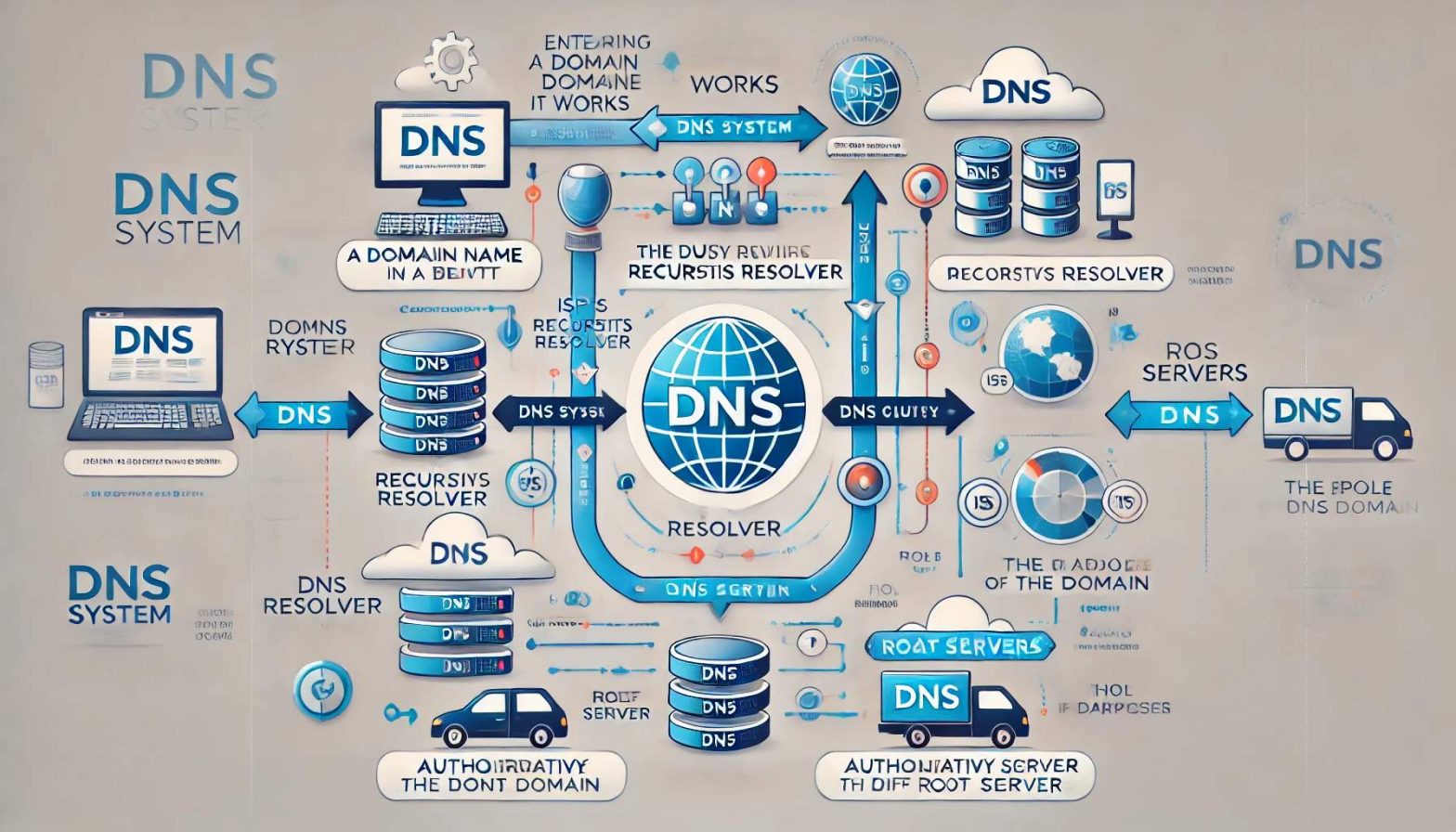The Domain Name System (DNS) is a foundational protocol that allows browsers to locate and load websites. It translates human-readable domain names (like example.com) into IP addresses, which are necessary for computers to communicate over the internet.
Key Steps in DNS Operation:
- Domain Query: When a user enters a website URL, the browser queries the DNS to find the corresponding IP address.
- Recursive DNS Resolver: The query is sent to a DNS resolver, which checks its local cache to see if it already knows the IP address.
- Root Server: If not cached, the resolver sends the request to a root server, which directs it to the appropriate Top-Level Domain (TLD) server (e.g., for .com or .org).
- TLD Server: The TLD server responds with the authoritative name server for that domain.
- Authoritative DNS Server: Finally, this server provides the correct IP address for the requested domain, allowing the browser to connect and load the website.
Major DNS Protocols:
UDP (User Datagram Protocol): Primarily used for DNS queries due to its speed, although it is less reliable.
TCP (Transmission Control Protocol): Used for DNS zone transfers and in cases where UDP queries fail.
DNSSEC (DNS Security Extensions): Adds security to DNS by validating responses, ensuring they haven’t been tampered with.
DNS Applications:
- Web Browsing: Converting domain names into IP addresses for user access.
- Email Routing: DNS is crucial for mail servers, using MX records to find the destination of emails.
- Content Delivery Networks (CDN): CDNs use DNS to distribute traffic to various geographically distributed servers for faster content delivery.
New Developments in DNS:
Encrypted DNS: With growing concerns over privacy, technologies like DNS over HTTPS (DoH) and DNS over TLS (DoT) have emerged. These protocols encrypt DNS queries, preventing third parties from intercepting and manipulating them.
Next Generation DNS: Efforts are underway to improve DNS performance with technologies like DNS Fast Flux and Anycast Routing, which enhance speed and reliability, especially for global services.
By leveraging a deep understanding of how the Domain Name System (DNS) works, users can enhance their internet performance and solve common issues effectively. For instance, switching to faster public DNS servers like Google (8.8.8.8) or Cloudflare (1.1.1.1) can improve browsing speed. Regularly clearing your DNS cache helps avoid DNS cache poisoning and ensures that your browser retrieves the most current IP addresses. Additionally, using encrypted DNS protocols such as DNS over HTTPS (DoH) and DNS over TLS (DoT) protects your data from being intercepted.
Common DNS Issues and Troubleshooting Tips:
- Slow DNS Resolution:
Solution: Switch to faster public DNS servers like Google DNS (8.8.8.8) or Cloudflare DNS (1.1.1.1). This can reduce lookup times. - DNS Cache Poisoning:
Solution: Clear your DNS cache regularly and use DNSSEC to protect against forged responses. - DNS Server Not Responding:
Solution: Restart your router or switch to another DNS server. Use the command ipconfig /flushdns to clear local cache. - Incorrect Website Display or Errors:
Solution: Flush DNS using system commands (ipconfig /flushdns for Windows or sudo dscacheutil -flushcache for macOS).
DNS Tips and Tricks:
Custom DNS Settings: Configure DNS settings in your router for the entire network, ensuring faster and more reliable browsing.
Use Secondary DNS Providers: Set a secondary DNS server in case the primary one fails.
Privacy-Oriented DNS: Use DNS providers like Quad9 (9.9.9.9) or Cloudflare’s 1.1.1.1, which emphasize user privacy and security.
DNS Troubleshooting Commands:
- Flush DNS Cache:
Windows: ipconfig /flushdns
macOS: sudo dscacheutil -flushcache
Linux: sudo systemctl restart nscd - Change DNS Settings:
In your network settings, update your primary and secondary DNS servers to public DNS providers like Cloudflare or Google. - Check DNS Server Health:
Use the command nslookup or dig to check if a domain is resolving properly. - Inspect for DNS Leaks:
Use online tools like dnsleaktest.com to ensure your DNS queries are private, particularly when using a VPN.
DNS Best Practices:
Set Up a Local DNS Cache: This reduces repeated DNS lookups and accelerates web access.
Use DNSSEC: Enable DNSSEC to validate DNS queries and protect against data tampering.
Optimize Router DNS Settings: Apply DNS configurations on the router level to provide a streamlined browsing experience for all devices on your network.
Various DNS Servers Overview: Features, Advantages, and Disadvantages
- BIND (Berkeley Internet Name Domain)
Features: Highly configurable, supports all DNS record types, DNSSEC support, commonly used for enterprise and ISPs.
Advantages: Open-source, highly flexible, widely supported.
Disadvantages: Can be complex to configure and manage, resource-intensive. - Unbound
Features: Recursive DNS server, DNSSEC validation, supports DNS-over-TLS and DNS-over-HTTPS.
Advantages: Lightweight, strong privacy features, fast and secure.
Disadvantages: Limited zone management capabilities compared to BIND. - PowerDNS
Features: Supports both authoritative and recursive modes, DNSSEC support, API access.
Advantages: Fast performance, robust API, modular with support for database backends.
Disadvantages: More complex to configure than other DNS solutions. - Knot DNS
Features: High-performance authoritative DNS server, supports DNSSEC, dynamic updates.
Advantages: Optimized for performance, lightweight, great for large-scale deployments.
Disadvantages: Primarily designed for authoritative DNS, less suited for recursive functions. - NSD (Name Server Daemon)
Features: Authoritative DNS server, supports DNSSEC, highly secure.
Advantages: Lightweight, simple configuration, ideal for authoritative-only DNS setups.
Disadvantages: Lacks support for recursive DNS queries. - djbdns
Features: Secure, modular DNS server suite, with separate services for different functions.
Advantages: Strong security focus, modular design, easy to maintain.
Disadvantages: Lacks modern features like DNSSEC, not widely used anymore. - Windows Server DNS
Features: Integrated with Windows Server, supports dynamic DNS, DNSSEC, Active Directory.
Advantages: Seamless integration with Microsoft environments, easy to manage in Windows.
Disadvantages: Limited to Windows environments, higher licensing costs.
Conclusion:
Choosing the right DNS server depends on the specific needs of your infrastructure. For enterprise-level DNS management, BIND and PowerDNS offer powerful flexibility and control. For simpler setups focused on speed and security, Unbound or NSD might be ideal. Knot DNS excels in high-performance environments, while Windows Server DNS is optimal for Microsoft-centric networks.
